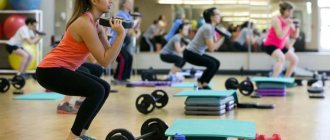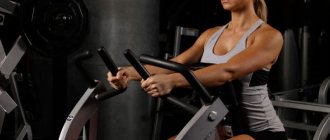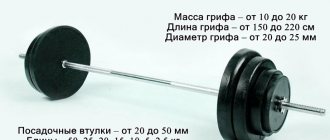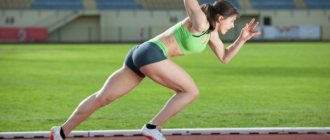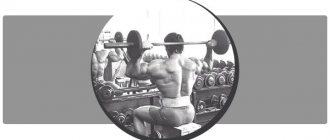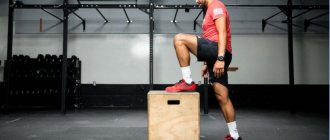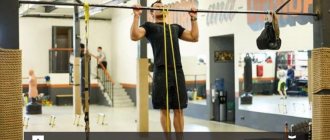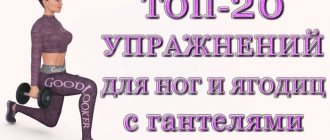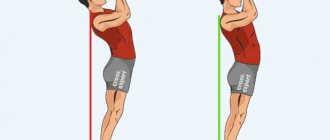Greetings to everyone who loves sports, health and a beautiful body. Today we will touch on an incredibly effective type of training, which is undeservedly deprived of popularity in the CIS countries. Pump or pump aerobics is the ideal combination of strength training and aerobics, which allows you to benefit from both types of exercise.
If you still believe that it is impossible to build muscle and burn fat at the same time (a popular misconception), then you probably haven’t tried a body pump. In this article I will talk about all the advantages of pump aerobics, the principles of constructing the training process and other features that will help you achieve an ideal figure and good health.
What it is
Body Pump (or simply pump) is an effective technique that can be called a strength-training branch of aerobics. It is calculated:
- To improve tone and muscle volume.
- To eliminate excess fat.
- To strengthen the body and general health.
By the standards of modern fitness trends, pump aerobics is an intense and energy-consuming sport. The entry threshold for full-fledged long-term training is quite high, but today almost all clubs have groups for beginners, so difficulty will not be a serious obstacle.
The main difference between body pumps and other areas of fitness is the intensity of the training. It is achieved not by increasing the weight of the weights, but through almost continuous work (with minimal rest) and a large number of repetitions.
Moreover, during training, all the muscles of the body are involved in the work (I especially want to highlight that the movements in the pump are basic in nature, isolation exercises are not used). This type of work provides not only a powerful hormonal response, but also increased calorie expenditure. As a result, pump aerobics increases muscle mass and burns fat.
In most cases, pump training, like any type of sports aerobics, is carried out in a group format. No one will stop you from performing any pump complexes at home. To do this, it is enough to have a barbell or a pair of dumbbells, as well as a step platform (although if you really want, a couple of water bottles will do instead of weights).
Brief history of origin
The rights of the creators of the method belong to the Les Mills International brand, which was created by Philip Mills (the brand is named after Philip’s father, a famous New Zealand track and field athlete). This company brings together professional trainers, sports doctors and other specialists to develop innovative training methods. Body Pump was the company's first method, which appeared back in the 90s of the last century, although the program became popularized later.
A big leap in the development of pump was the adaptation of training to the conditions of ordinary fitness clubs and even at home. This was also facilitated by the development of functional sports.
Currently, Les Mills is a world-famous brand that has patented techniques (not counting the classic body pump). They are actively used in various sports: from correcting excess weight to training professional fighters.
Body pump training - exercises and how to do them
The lesson begins with a warm-up. Every muscle group in the body is warmed up, starting from the neck and ending with the legs. All exercises are performed to music, the rhythm is constantly changing. When performing exercises at home, you should carefully follow the instructions of the instructor , trying to do everything as accurately and correctly as possible.
When performing exercises, it is important to remember proper breathing. If you breathe incorrectly, intracranial pressure increases, pain and dizziness appear.
After warming up, exercises with barbells begin. To perform the first exercise, take a barbell with a small weight and place it on your shoulders.
The first exercise is squats. It is important to take your time and listen to the rhythm of the music. The chin goes up. Then the squats turn into lunges. When the lunges are completed, you need to perform stretches by removing the barbell.
The entire workout consists of 8 parts, each part is working with a specific muscle group to the appropriate music. The main advantage of the exercises is the high repetition rate and high tempo of the exercises.
When exercising with a barbell it is important:
- the barbells do not lie on the neck, but on 2 points of the trapezoid;
- The elbows are not directed towards the floor, but slightly back.
When performing exercises, it is important to place the barbell correctly
. Body pumps are so effective because there is no muscular adaptation to the load. As soon as “acclimation” occurs, the exercises change and the muscles work intensively again.
Each exercise has its own music track. This helps you tune in to rhythmic execution and is a great mood lifter.
The essence of training
The main goal of training is to perform almost continuous work with alternating intensities.
Often the training load alternates. For example, after performing a long strength complex of one or a couple of exercises, an active rest phase follows (to restore breathing and energy). During this phase, athletes perform exercises without weight (most often these are complex movements, from side-stepping lunges to burpees).
In addition to performing the required volume and sequence of exercises, an important task in pump training is to work in high pulse zones. This promotes fat burning and does not interfere with exercise to gain weight.
The entire workout takes from 45 to 60 minutes, including the warm-up and cool-down phase.
I want to immediately clarify that a body pump is not an ordinary pump in the bodybuilding format. Moreover, this is not the typical circuit training that is often used in the gym for weight loss. Pump is a special technique where exercises occur in strict sequence.
Every season the body pump program is updated, this includes changes in training patterns, exercises and even music. Therefore, it is important to immediately understand that pump is a technique that is built on science and years of practice, and not a banal series of exercises. It can only be like this in the hands of non-professional instructors.
Let's summarize and list the main advantages of the pump method:
- Varied and exciting workouts (group exercises accompanied by dynamic music).
- Simultaneously develops aerobic endurance, strength, coordination and balance.
- Strengthening the cardiovascular system.
- Development of muscles (although you will not achieve excessive hypertrophy, as in bodybuilding; rather, we are talking about the natural volume and general aesthetics of the figure).
- Quickly burn excess fat.
I also want to note that the body pump method is designed for the general public, therefore it implies gradations of complexity. They manifest themselves both in the intensity of training and in the combination of exercises. The initial level of pump is accessible to almost all people, regardless of age and physical fitness, but more professional programs may seem difficult even for advanced athletes.
What muscles work
In order not to list all the working muscles, I will say briefly - the whole body works in the pump, and this is not an exaggeration. This is “built into” the essence of the pump method, which involves performing the most functional, energy-consuming and complex movements. Therefore, one of the main advantages of the program is the most comprehensive development of the body (not only all muscles, but also abilities). During body pump classes, even those muscles that are not included in the work during regular workouts in the gym will be used.
During most of body pump training, athletes actively work their core muscles in an active or passive mode. Therefore, a body pump is one of the best training options for men who want defined abs.
Kinds
When it comes to the types of pumps, even among trainers there is often confusion, which is associated with the spread of misconceptions. I want to upset those who signed up for various techniques in the style of X-pump and other similar names. This is not the original pump at all and may have nothing in common with the original workouts developed and continually improved by Les Mills. More often, such moves are used by fitness club chains to attract customers.
The reason for the tricks is simple - Body Pump (this is the name of the real pump program) requires mandatory certification of trainers at Les Mills, as well as the acquisition of a license to conduct classes. Unlike some “pamp” that was launched at a local fitness chain. Therefore, if your trainer cannot show such Les Mills certification, then you are training using an interpreted method, which may be very different from the original pump.
Among these are the following areas:
- Pump Challenge.
- Pump and Shred.
- Pump Revolution (in Russia it is often called “longer” because of the maximum duration of the lesson).
- Pump and Burn.
- Flow.
- Pump Extreme.
- Pump Basics.
- Hardcore Abs.
- Sports Attack.
- Les Mills step.
- Combat.
Recommendations
Before you start training, it will not be superfluous to familiarize yourself with the basic recommendations of specialists. It is not so difficult to learn them, so it is better not to leave these nuances without attention. These include the following points:
- the first workouts should be carried out with minimal weights - excessive loads should be avoided;
- when exercising at home, it is necessary to provide a sufficient amount of fresh air by conducting training outside or in a well-ventilated area;
- you should maintain regularity of exercise, without missing a single training day, otherwise, after a long period of rest, the muscles will become very sore after performing even the simplest exercises;
- the working weight for experienced athletes involved in pumping for more than a month, regardless of the conditions, should not be too small or large - in the first case, no result will be obtained, in the second, the exercises will be difficult to perform correctly and fully, and the risk will increase getting injured;
- the trainer’s words and advice should be taken seriously, because he knows about the benefits of training and a person’s capabilities much better than a beginner;
- the music should not be too loud, since it is only a background and the main source of the rhythm of training, and not an accompaniment that hurts the ear and does not allow concentration;
- There must be a break of two to three days between classes so that the muscles have time to recover, so during this period only light cardio is allowed, but not other strength exercises.
Is it suitable for those losing weight
More than suitable. Pump is a super effective way to lose weight. It eliminates the main drawback of any fat burning program - loss of muscle mass.
Almost all fitness programs that are aimed at losing excess fat will inevitably burn out your muscles. Even regular jogging is not without this drawback. In pump aerobics there are no such losses, since strength exercises are performed to a greater extent with minor weights (insignificant - from the point of view of those already training, for beginners they can seem very heavy).
For example, girls squat with a weight of 20 kg, and for the bench press they take a barbell with weights of about 12-13 kg. Dumbbells in the body pump are used with a weight of 5-7 kg, sometimes barbell weights (2.5 kg) are used.
I want to assure you that body pump is more effective than most types of cardio and is almost twice as effective as regular aerobic training. The fact is that for effective fat burning you need both strength and long-term low-intensity loads.
The goal of strength work is to force the body to respond to stress by releasing large amounts of hormones (which will effectively burn fat even during a period of rest). They break down fat deposits and “release” fats into the bloodstream, after which they are used by muscles. And here the role of long-term cardio comes into play, since it is during aerobic exercise that the fat that is in the muscles burns. This tandem in the body pump ensures maximum speed of loss of excess fat without reducing (and even increasing) muscle mass.
Pros and cons of bodypump
Advantages:
- Strength aerobics is suitable for both men and women, since the training takes place with a barbell of a weight suitable for the athlete, as well as familiar gym exercises in various improved variations.
- In one hour-long workout, all major muscle groups are worked out, receiving full load and becoming toned.
- Training helps to get rid of excess weight, burns fatty tissue due to multiple repetitions and non-stop mode.
- The workout takes place at a comfortable pace, suitable for strength exercises, which does not cause discomfort to breathing and the heart muscle, as with high-intensity aerobic exercise.
Flaws:
- Despite working with a barbell, the workout does not promote muscle gain; due to the large number of repetitions, the exercises develop endurance, not muscle mass.
- Before starting classes, it is recommended to undergo a little physical training, since the exercise technique for unprepared muscles can be traumatic.
Indications and contraindications
The list of indications for the pump is quite large and significantly exceeds even classical fitness.
The main indications include:
- Correction of the figure and getting rid of excess fat.
- A significant shift in the balance of fat and muscle mass (I want you to understand that the pump is not just a weight loss program, the technique is aimed at developing the entire body).
- Strengthening the cardiovascular system.
- Strengthening the immune system.
- Increased endurance.
- Improved muscle tone.
- Prevention of physical inactivity.
- Improved coordination of movements.
Contraindications should be divided into two categories:
- Absolute.
- Conditional.
With the first category, body pump classes are completely prohibited; with the second, compromises are possible (in the form of special groups or reducing the load).
Complete contraindications include:
- Chronic diseases in the acute stage.
- Pregnancy period (1st and 3rd trimesters) and breastfeeding.
- Oncological diseases.
- Hypertension and other problems of the cardiovascular system.
Conditional contraindications include problems of the musculoskeletal system (admission to training is assessed individually, depending on the state of health), varicose veins and too low a level of physical fitness.
The classic pump is quite complex in terms of intensity and load, so beginners may need to strengthen their muscles and cardiovascular system before starting to train using this method. The preparation period usually lasts from 2 to 6 months, although in special body pump groups for beginners the adaptation process may occur faster.
Aerobics barbell Body pump
Some people feel embarrassed when they find themselves in the gym next to pumped-up, trained people. Body pump lessons will bring self-confidence because such classes have a clear sequence.
At the first level, it is proposed to use only the barbell - this will make it easy to cope with the trainer’s tasks. Gradually the tasks become more complicated and the weight increases.
It is better to purchase a polyurethane barbell for body pumping.
If a person wants to exercise at home, then he needs to purchase a barbell. Online stores will be the best option, since many offer delivery directly to your home. Before making a purchase, you should take a good look at the barbell that is used in the lesson.
Body pumps (the so-called barbells for doing this aerobics) are made of various coatings. Experts say that of all materials, polyurethane is the most reliable and durable .
When purchasing a barbell, you should pay attention to the locks. The safety of the practitioner depends on them, since they are responsible for the strength of holding the pancakes.
In addition to the barbell, the classes require dumbbells and a step platform.
Benefits and harms of body pump
Assessing the pros and cons of pump aerobics, I can safely agree that Les Mills is not in vain known throughout the world and is considered the training elite. The program is truly built on science and numerous sports studies, and then adapted to people with different levels of physical fitness. The number of advantages many times overshadows any possible disadvantages, most of which are leveled out with a competent approach by the trainer to building a training scheme.
The clear advantages of pump include:
- Simultaneous muscle growth and fat burning.
- Generally accessible to people of different ages, levels of physical development and sports experience.
- Significant development of strength and aerobic types of endurance.
- Development of coordination and balance.
- Prevention of many diseases - from prostatitis in men to hormonal changes in women (I want you to understand that this is not about treatment, but about prevention).
There are only two disadvantages to the body pump method - the lack of experienced trainers and the complexity of classes for beginners. The first disadvantage can be corrected by enrolling in a gym that officially works with Les Mills and has certified trainers, and not some “author’s” techniques with a similar name, like Power Pump and others. The second disadvantage is solved by preliminary preparation, when you do not immediately “dive into the hole,” but gradually prepare your heart, muscles and central nervous system for the loads of a body pump.
Advantages
The advantages of a body pump are undeniable. They are so great that it is very difficult to resist the temptation to try a new technique on yourself. Intense strength aerobics has become widespread due to the following benefits:
- music for body pump motivates and energizes;
- the training has an integrated approach, as it combines strength and aerobic exercises;
- the fast pace of the lesson allows you to start active fat burning;
- within an hour, the gluteal muscles work, as well as the shoulders, back, arms and legs;
- the intensity of the load can be adjusted by decreasing or increasing the weight of the projectile;
- training is available to everyone.
A simple exercise technique and the right approach to exercise will help you quickly achieve a beautiful and healthy body. The advantages of the pump make you think that there is an opportunity to join people who have already started training using this system. You can spend just 60 minutes even with a sedentary lifestyle, because the effect will not take long to appear.
How to practice at home correctly
Les Mills has an entire course designed for home workouts. It includes videos, theoretical materials and everything that can replace a trainer at home. But the course costs a lot of money, so it’s better to go to a one-time lesson (usually they are free), see the essence of the training, and then simply adapt the principles of the method to training at home. Next, I’ll look at an example of body pumping at home, which can be a good starting point for beginners.
Necessary inventory and equipment
Pump is an unpretentious sport when it comes to extra expenses. All you need for training is comfortable clothing and minimal equipment.
Suitable for body pump:
- Barbell (Olympic bar is not suitable for body pumps, “home” or EZ bars are required).
- A pair of dumbbells.
- One or two weights of the same weight (we are talking about small weights for aerobics and body pump).
- Sandbag (or one sandbag attachment, from 5 to 15 kg).
- Step platform (or any replacement thereof).
- If you have a desire to train, then the pump method can be used even without special equipment. Several bottles of water are suitable for this (6-8 liters to simulate a barbell and 2 liters for each hand).
There are no special restrictions regarding pump clothing. The T-shirt and pants/shorts should be comfortable, absorb sweat and not interfere with movement. Shoes - regular sneakers with soft soles (gel, foam or similar) and foot cushioning. Any special shoes, like the zpump from Reebok (who made a body pump model), are not necessary. This is ordinary marketing and such shoes do not provide a real advantage in body pumping.
Nutrition and supplements during exercise
The food should be dietary, there is no need to adhere to strict diets, you will already spend a lot of calories in the pump. But some supplements are preferable; they will help provide the body with everything it needs for training and recovery.
I consider the main additives for pump:
- Protein - for obtaining amino acids.
- Creatine - increases endurance and strength.
- BCAA - will help to further protect muscles from destruction during body pump training (can be excluded by replacing it with an additional portion of protein an hour to 30-60 minutes before training).
- Isotonic - to replenish electrolytes during training.
Vitamin-mineral complexes and omega-3 would be preferable for a pump, especially if you train in the autumn-winter period, when the diet is less varied. If you lack energy, you can use green tea extract or capsule caffeine.
Where to start first
I recommend starting your journey into body pumping by becoming familiar with the essence of the technique, its features and the principle of constructing the training process. If you work out in the gym, then the trainer will explain all this.
Pump workouts always begin with a full-body warm-up for 5-10 minutes, where attention is paid to each muscle group and joint group.
Number and duration of training
In body pump there is no single template, as in fitness - “go to the gym 3 times a week and work out for an hour.” Everything is determined by the features of the program, the intensity of classes and training in each season. But a certain standard in pump still exists. The duration of training rarely goes beyond 20-55 minutes, depending on the type of activity. And the number of workouts per week varies from 2 to 3 (2 for beginners and 3 for advanced).
What time to train
There is no single answer because everyone's biorhythms can be very different. The greatest productivity is demonstrated by:
- Training in the morning (from 10 to 12 o'clock).
- Evening classes (from 17.00 to 19.00).
It’s better to schedule pump classes around these hours, or do them when it’s convenient and you have the strength.
Aerobic endurance
A body pump, of course, helps improve endurance, but you can’t do it without additional aerobic exercise. They are a must for people who are overweight and want to achieve results as quickly as possible. Aerobics will help you become more resilient in your core workouts.
The most beneficial options for combining training will be the following:
- after the pump, half an hour of “even” cardio on a treadmill or stepper with high amplitude;
- two workouts with a barbell and aerobics per week;
- the same number of pump sessions and additional jogging in the fresh air or swimming in the pool 3 times every 7 days.
Correct technique and basic body pump exercises
Maintaining the correct technique is the main element of successful bodypump training. Given the high intensity and duration of classes, as you get tired, the technique in the exercises may deteriorate, so you must monitor your every movement.
Basic body pump movements include:
- Barbell presses (performed both lying down and on a step platform).
- Shvung press.
- Squats.
- Lunges.
- Bent-over barbell row.
- Romanian cravings.
- Broach.
- Barbell curls for biceps and presses for triceps.
- Abdominal exercises.
Also often used in the body pump are planks, plyometric movements and various variations of all of the above exercises (with changes in grip, speed of execution).
Who is it suitable for?
During the training process, athletes perform the following exercises to rhythmic music:
- press press;
- deadlift;
- isolating barbell lifts for triceps and biceps;
- lunges and squats;
- mini-barbell presses on the steppe.
This type of training is ideal for weight loss for people who have previously had no connection with sports. If you don’t change your diet and eat “everything in a row”, while suddenly starting to do strength exercises, the extra pounds will go away quite quickly. When the weight loss stops and freezes in one place, you will need to switch to proper nutrition. In this case, we can already talk about a full-fledged healthy lifestyle.
Sample workout program at home
It is almost impossible to post a complete body pump workout program. Firstly, because pump is a licensed commercial product, and secondly, because it would be necessary to describe dozens of different training programs and hundreds of exercises (it’s not for nothing that they are sold only on DVD). I will give an approximate pump program for different levels of training as an example to understand the methodology itself.
For beginners
An example of body pump training for beginners. All exercises are performed in two approaches, 45 seconds each. The break between approaches is 15 seconds. Rest between exercises - 30 seconds. Exercises without changing the tempo are performed at an average speed, no more than 3 seconds for both phases of movement. Try to select a weight that will allow you to perform all the exercises in this mode until muscle failure.
Pump training scheme:
- Warm up.
- Bent-over barbell row.
- Trusters.
- A series of lunges on each leg.
- Bench press at a slow pace (4-5 seconds lowering and explosively raising the bar).
- Jumping up in place.
- Pushups.
- Swing to the sides while raising your arms up (with dumbbells or weights).
- Burpee.
- Press press (the lifting phase is forced, the lowering phase is slow).
- Twisting.
- Leg raises while lying on a step platform.
For advanced
The body pump program for advanced people often includes different cycles with changing load, tempo and other conditions. To master the program, it is executed one by one, one cycle after another. For each exercise, 45 seconds of work and 15 seconds of rest are allotted. Rest between cycles - 2 minutes.
For groups more experienced in body pumping, the first two cycles are performed 2 times (that is, 1, 2, 1, 2, after which the third is final). On the second repetition of the first and second cycles, all exercises are performed at the same pace, without delays or forced movements. Rest between exercises is 30 seconds. By this time, the muscles will be tired and acidified, so the use of various pump techniques will be unnecessary.
This is an example of an advanced body pump program.
First cycle:
- A combination of a bent-over barbell row with a biceps press (the row is performed first, then the press, after straightening the back).
- Alternate stretching with a push press.
- Squats with alternating tempo (1 very slow through three fast).
- Back lunges on each leg.
Second cycle (adds weight on the bar):
- Squats with increasing speed (squats are performed from ultra-slow at the beginning to very fast for the last repetitions of the set).
- Bench press on the steppe (1 slow through 3 fast).
- Bent over arm abduction (triceps).
- Slow barbell lift for biceps.
Third cycle (repeating the second with less weight on the bar).
Final cycle:
- Jumping jack.
- Standing power jumps.
- Step platform push-ups.
- Bent-over dumbbell raises.
- Side crunches.
- Leg raises in a lying position.
- Plank with alternating support on the palms and elbows.
After the main body pump workout, stretching is performed on all muscle groups (2-3 minutes).
A set of pump aerobics classes
The weight of the barbell must be changed during training. For the legs, back, and chest, heavier weights are appropriate than for the deltoids, triceps, and biceps. After each block (muscle group) there is a short pause to change the weight. Warm up muscles and joints – 5-7 minutes.
Squats
- Place your feet hip-width apart, squat 2 counts down and 2 counts up (2:2). Perform 4 reps.
- Squat down quickly for 1 count, and slowly rise up for 3 counts (1:3) – 4 times.
- Squat down slowly for 3 counts, and quickly straighten your torso for 1 count (3:1) – 4 times.
- Squat and rise at the same pace for one count (1:1) 8-16 times.
Back (thrust to the belt)
- Standing with your feet hip-width apart, bend your back parallel to the floor. Hold the barbell with a medium grip and straight elbows. For 2 counts, pull the barbell to the bottom of the belt, for 2 counts, lower it - 4 times.
- For 3 counts, slowly raise your hands to your waist, and for 1 count, lower them, but without jerking. And so 4 times.
- For 1 count, quickly raise the barbell, for three counts, slowly lower it - 4 times.
- Raise and lower your arms for each count 8-16 times.
Chest (bench press on platform)
- Hold the barbell with a wide grip and place it above your chest with your arms outstretched. For 2 counts, lower the barbell to the middle of your chest, for 2 counts, press up - 4 times.
- Slowly lower the barbell down for three counts, and press it up for one count – 4 times.
- For one count down, and for three, slowly straighten your elbows up – 4 times.
- Press for each count 8-16 times.
Triceps (arm extension with barbell plates)
The exercise is performed standing or sitting. Hold the plate with both hands, raise your arms above your shoulders, lock your elbows in one place.
- Lower and raise your arms in two counts (2:2) – 4 times.
- Lower by three counts, raise by one (3:1) – 4 times.
- Unbend in 1:3 mode (down/up) – 4 times.
- Extension for each count (1:1) 8-16 times.
Scissor lunges
- Sit down and straighten your knee for two counts 4 times (2:2).
- Perform the 3:1 mode - 4 times.
- Perform mode 1:3 - 4 times.
- For each count (1:1) – 8-16 times.
Same on the other side.
Shoulders: standing press
Place the barbell on your shoulders behind your head and hold it with a wide grip.
- Overhead press 2:2, extend your arms above your head and gently lower them behind your head. And so 4 times.
- Press 1:3 - 4 times.
- Press 3:1 - 4 times.
- Press 1:1 – 8-16 times.
Front swings
Hold the barbell in front of you on your hips with a shoulder-width grip, elbows slightly bent to the sides.
- Swing in front of you to eye level without swinging your back (2:2) – 4 times.
- Max 1:3 – 4 times.
- Max 3:1 – 4 times.
- Max 1:1 – 8-16 times.
Biceps standing
Hold the barbell with a medium grip underneath your hips, without rocking your back.
- Arm bending 2:2 – 4 times.
- Bend 1:3 – 4 times.
- Flexion 3:1 – 4 times.
- Bending 1:1 – 8-16 times.
Press
Lying on your back, bend your knees and place your feet on the floor. Place the plate on your bent arms in front of you.
- Perform short half-amplitude crunches (2:2) – 4 times, without lifting your lower back from the floor.
- Twisting 1:3 – 4 times.
- Twisting 3:1 – 4 times.
- Twisting 1:1 – 8-16 times.
Leg Raise
Place your palms under your buttocks, legs straightened on the floor, do not lift your back from the floor, constantly tense your abdominal muscles.
- Raise your legs up, lower them to the floor and return to the starting position (2:2) – 4 times.
- Raise 1:3 – 4 times.
- Raise 3:1 – 4 times.
- Raise 1:1 – 8-16 times.
If it becomes easy, the number of exercises can be doubled.
Finish the complex with stretching for all muscles.
Video tutorials Les Mills in Russian
For those who don't really want to think through their workouts, there is a ready-made option - a series of Les Mills videos on disc or in digital format. A complete workout guide, music and instructions are included, along with proper exercise technique.
Training in specialized gyms has one important advantage - the programs are updated every season, and micro-changes are made in almost every training session. Therefore, this training option will be preferable if assessed from the point of view of maximum benefit.
https://www.youtube.com/watch?v=wWKt6C8VDFU&feature=youtu.be
Body pump for weight loss. Calorie consumption
Mostly women who go to fitness pursue one, well-known goal - to lose weight. A body pump is a great help in this, but one of the important aspects is proper nutrition.
Researchers from Brazil conducted an experiment in which women participated in a body pump program, but did not monitor their diet. As a result, they failed to lose weight.
Body pump training is an excellent help in acquiring the desired figure, but if you combine it with a balanced diet and other exercises.
Combining body pumps with other physical activities - for example, swimming in a pool - increases the effectiveness of training.
Such activities include:
- swimming in the pool;
- run;
- cardio training;
- any other aerobic activity.
Official data states that the average person doing body pump will spend 500-600 kcal during the session. For reference: athletes performing exercises with heavy weights burn about 250 kcal.
The hated calories will also be burned after exercise - while relaxing at home, this is achieved due to active protein synthesis during training.
Reviews and results
Oleg: “Before the body pump I did bb and thought that I was in good shape. At the very first training session, the pump died and suffered severe soreness! And this is after three years in the gym! After 5 months, the mass did not fall off, but the fat was very noticeably gone and the abs were clearly visible for the first time.”
Diana: “I absolutely love the fact that body pump training is done in large groups. There are 20 people working in ours, 4 of them are my friends. In the fitness club, everyone goes alone, but here we train as a single unit. It’s not only the coach that really pushes me, but also keeping up with others. I often caught myself thinking that I was working up a sweat just to keep up. Pump is super!”
Vikusya79: “I study at home. I didn’t make up my mind right away, but I finally bought the basic body pump course. I thought it was just another program that is sold everywhere. But in the end I didn’t regret it. Now my collection includes basic and advanced body pump courses. I don’t go to gyms; there are no qualified trainers in our area.”
Photos before and after
Photos of physical metamorphoses from pump exercises clearly show the effectiveness of this technique. This is the best confirmation of the professionalism of Les Mills and the fact that body pump is not a hyped dummy, but a truly innovative course.
Object of experiment
Scientists decided to conduct a study to prove the effectiveness of the training. They recruited 19 sedentary women who were in good physical health and able to tolerate strength training. At the same time, a mandatory condition was to attend two group classes twice a week. In total, this experiment took place over 3 months.
Before and after the test, experts measured:
- each participant's aerobic endurance by testing them on treadmills and measuring their heart rate at specific times;
- number of squats with additional weight;
- thickness of the fat layer;
- press strength.
As a result, the strength indicators of all 19 people increased by 33%. In addition, each woman lost several kilograms.
Circuit training Body pump
Circular training is called training, which entails the development of each muscle group. In addition, it plays a role in developing coordination, strength and endurance.
Circuit training allows you to use every muscle group
In body pump circuit training, all participants are placed in a circle. Each person is given their own exercise and equipment.
During the time allotted by the coach, everyone completes the assigned tasks.
Then positions change in a circle - and so on until everyone returns to their places.
